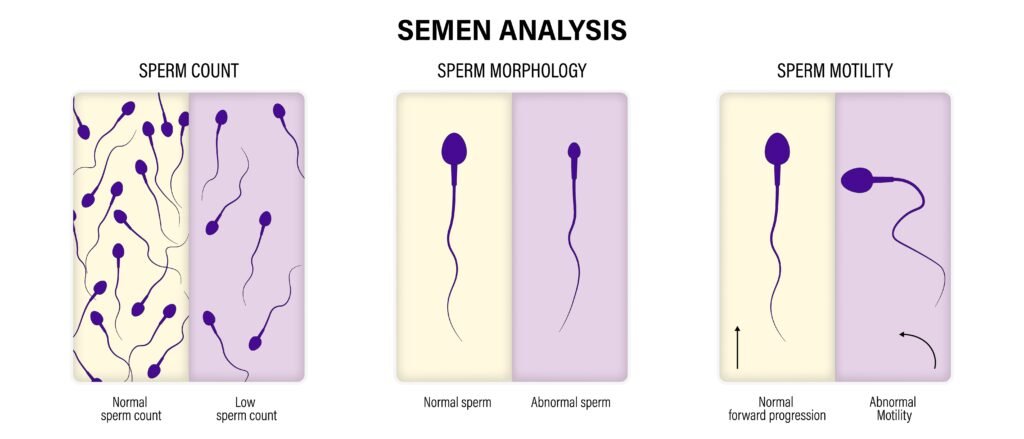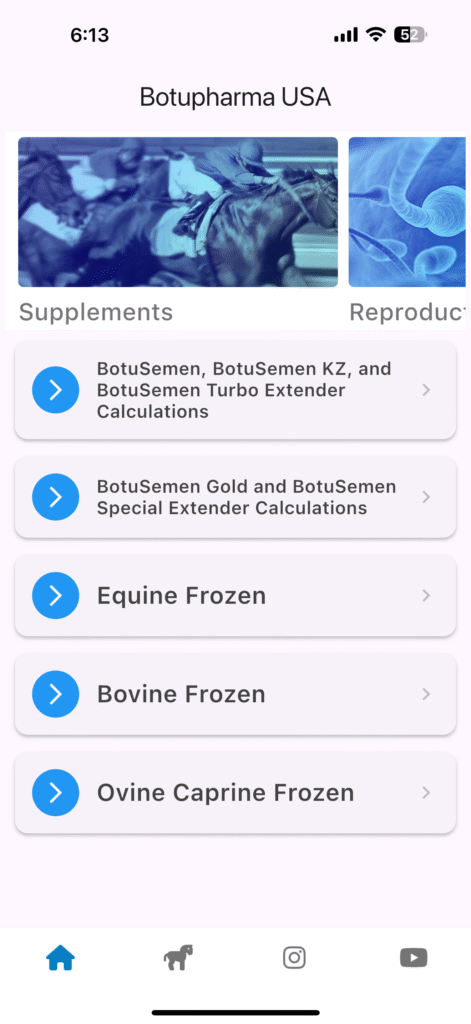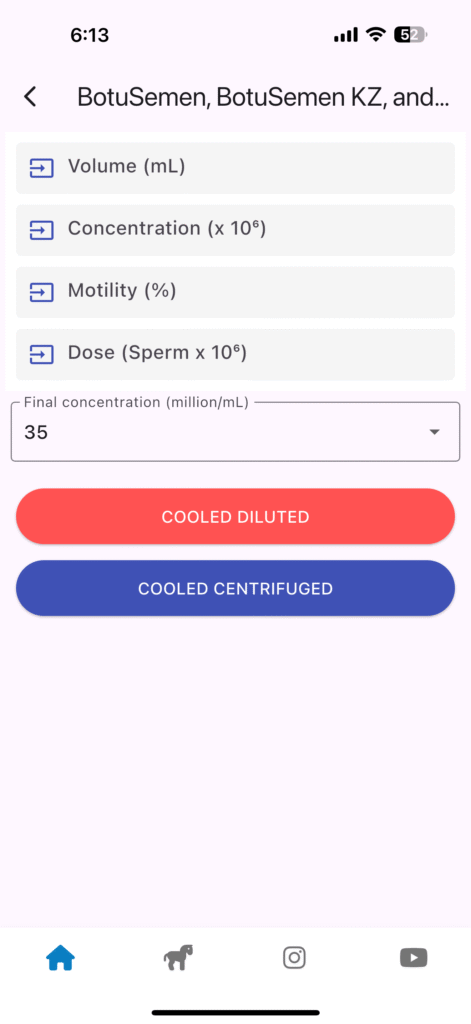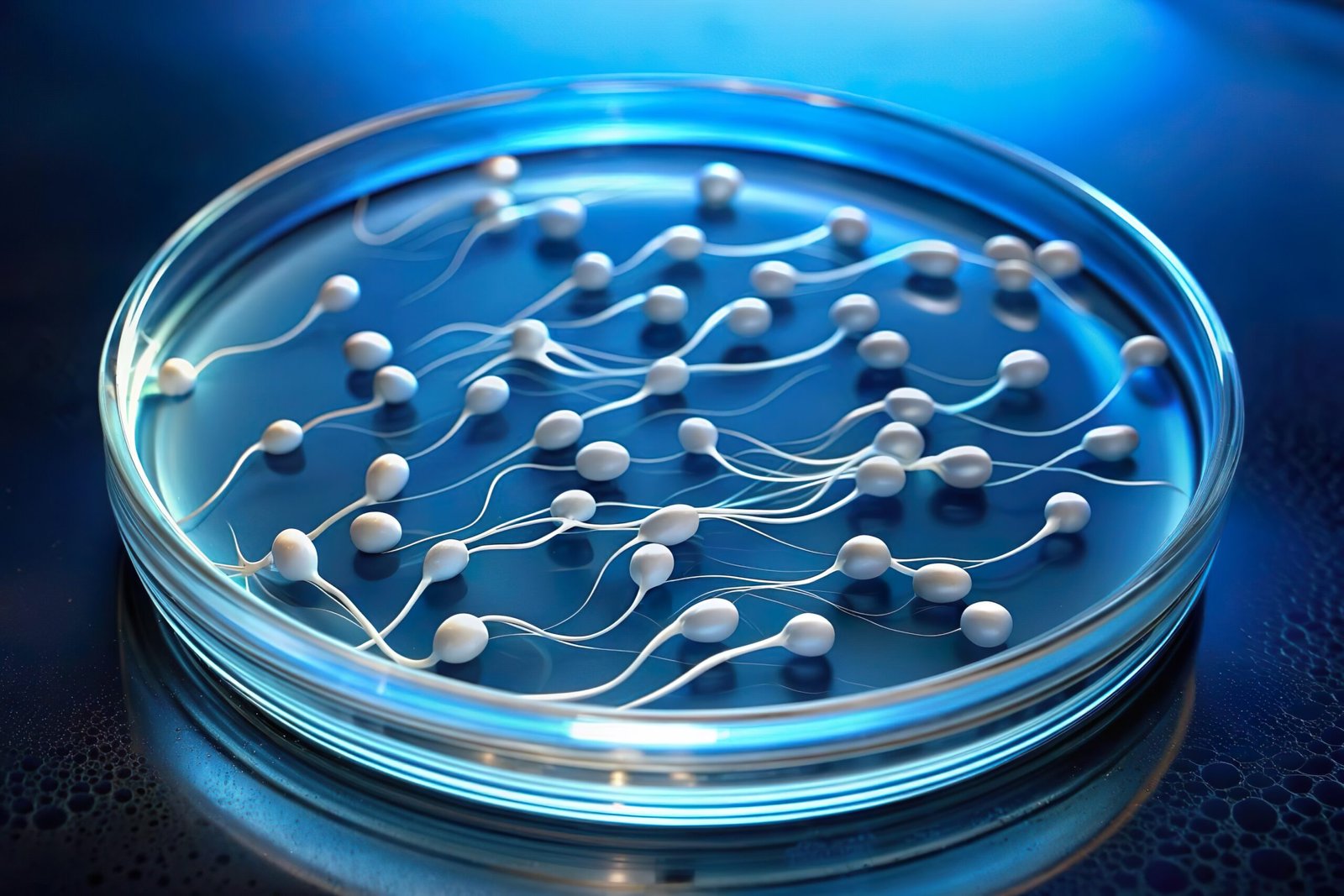Learn Equine Semen Analysis Like A Champion
By Heidi Schlenker
Why It’s Important to Learn Equine Semen Analysis as a Mare Owner
Each year social media is fraught with posts stating things such as “We received semen from x stallion and my vet said it was only 10%. What are my recourses for a refund” or “The vet said the semen we received was terrible, I doubt my mare gets bred”. In this article, we will explain semen analysis and processing for shipping, and how to determine if that dose of semen is as bad as your vet thinks.
I’d like to preface with this: when a veterinarian attends veterinarian school, they generally receive limited theriogenology (reproduction) courses, and they encompass most domestic species (dogs, cats, goats, sheep, cattle, horses, etc.). The amount of time they will spend learning Equine Reproduction is approximately the equivalent of a short course available to the public. After graduating, the newly minted veterinarian can choose to advance their degree in a theriogenology specialty, or they can do a residency with a clinic specializing in reproduction (those are few and far between).
Most commonly, the new veterinarian seeks a residency with an internal medicine clinic that may offer reproductive services but does not specialize in it. I am not advocating to not be trusting of your vet. However, I am advocating for you to find a reproduction specialist because the skill set for equine reproduction will be vastly different. Many people end up learning this over multiple cycles of open mares that are not necessarily hard breeders, but the veterinarian doing the work is just not as skilled in the specifics of reproduction.
Learn Equine Semen Analysis: The Characteristics of Equine Semen
Learning equine semen analysis starts with knowing the characteristics of equine semen. Equine semen is extremely fragile and susceptible to heat and cold shock (this is important), as well as UV light exposure. The wrong temperature can kill off an entire collection in minutes. An ejaculate is comprised of pre-ejaculate which contains the seminal plasma, the sperm-rich portion (containing the sperm), and followed by the gel fraction at the end of the ejaculate which gets filtered out of the collection before processing. When viewing semen under the microscope, the sperm should have a head, midpiece, and tail.
You will observe dead cells, sperm missing tails, sperm with detached heads, sperm swimming in circles, sperm swimming in straight or jagged lines, sperm with bent tails, normal sperm, and sperm that just sits there and wiggles the tail. Stallions with testicular degeneration will often have large round germinal cells in the semen (no tails) which are completely infertile, in addition to the sperm characteristics listed above, but that is an issue for a different discussion. To process the collection, you must account for the entirety of the ejaculate, and determine which cells are morphologically normal, and which cells are morphologically abnormal.

Morphology of Cells
Morphologically correct sperm with forward progressive motility are sperm that have a head, midpiece, and tail, with no defects, and that swim in a straight or semi-straight line with adequate velocity. These sperm are termed progressively motile morphologically normal (PMMN) or progressively motile sperm (PMS).
Sperm swimming in circles will be part of the total motility, but not the progressively motile percentage. Morphologically abnormal sperm are those with missing tails, detached heads, bent tails, nodules on the midpiece, dead cells, germinal cells, etc. The morphology of the cells must be taken into consideration and counted when processing an ejaculate for shipping or onsite artificial insemination so that the correct breeding dose can be calculated.

Motility
“There are two categories of motility – total and progressively motile sperm, which are usually expressed as a percentage of all sperm. Total motility indicates the overall percentage of sperm moving in any direction, whereas progressive motility indicates the percentage overall of sperm moving in, more or less, a straight line. A further category of non-motile is applied to sperm that are not moving” (Mottershead, 2013).
A progressively motile sperm should have at least 75% or greater level of straightness. When people refer to motility on social media sites, you will generally see them refer to a number such as 75%, 85%, or even 95% progressive motility. It is important to note that it is nearly statistically impossible for a stallion to have 95% progressive motility upon collection. Total motility, yes, but not progressive motility. Many stallion owners and laymen erroneously mistake total motility for progressive motility. It is rare for a stallion to achieve progressive motility of 75% or above upon collection, let alone at 24 hrs. old.
One comprehensive study found that 50%-60% progressive motility upon collection is the average for most stallions. This is an important fact to remember when evaluating semen using a subjective approach with a densimeter and microscope.
Subjective Evaluation
Subjective evaluation of the ejaculate is obtained with a sperm counter, such as the Quick Check Jr., Quick Check, or a densimeter, and a microscope with a warming plate. Unless the ejaculate is extremely dilute, it is nearly impossible to get an accurate determination of total or progressive motility with raw semen. It must be diluted with semen extender at a 1:1 ratio for an accurate evaluation under the microscope.
It is best to dilute semen to approximately 25 million sperm per milliliter for accurate evaluation of motility, which typically results in around twenty sperm visible in the microscope’s viewing field. If using a subjective method for evaluation and the semen appears to have about 80 percent total motility, it is more likely that the progressive motility is closer to 60 percent or less. This difference is important to understand when calculating the correct shipping dose.

Objective Evaluation
The CASA System (Computer Assisted Semen Analysis) analyzes the sperm with software technology for a more accurate evaluation of motility (total and progressive). When using a CASA system, it quickly becomes apparent that people evaluating motility under a microscope are usually overestimating the progressive motility. The CASA System is the gold standard for motility and velocity evaluation, and many will also determine morphology.

Processing the Semen
First, the concentration must be determined using a Quick Check, Densimeter, or other semen concentration calculation system. Next, the total volume of the semen must be determined. The volume will then be multiplied by the concentration to get the total number of sperm (TS). Once we have this number, we will extend the semen with one part semen to one part extender and put a small drop on the microscope slide to evaluate motility. On the slide, to the naked eye, my stallion’s semen is usually around 80%-85% total motility. Knowing the law of averages for progressive motility, I never calculate my progressive motility to be greater than 65%, and more often than not, I calculate my dosages at 60% progressive motility so that I know I am including enough progressively motile sperm in the dose.
Concentration x Volume = Total Sperm
355 million/ml x 40 mLs = 14.2 billion Total Sperm
Now that we have the total number of sperm and the total motility, we multiply the total number of sperm by the progressively motile sperm percentage.
Total Sperm 14.2 billion x 60% (progressive motility) = 8.52 billion PMS
This translates to 8.5 doses of cooled shipped semen using a progressively motile sperm dosage.
For years, the industry standard in the United States has been to ship a minimum of 1 billion progressively motile sperm per dose, anticipating a 50% die-off rate by 24 hours, leaving 500 million progressively motile sperm for insemination. However, recent research has proven that 200 million progressively motile sperm at the time of shipping, leaving approximately 100 million progressively motile sperm at the time of insemination is sufficient with a suitably timed ovulation. Conception rates do not decline until you get doses under 100 million progressively motile cells at the time of insemination with a suitably timed ovulation (Mottershead & St. Martin, 2020). However, it is not wise to send such low progressively motile doses.
Once the math is completed, the semen is then extender further with the semen extender that works best with the stallion with a suitable ratio dependent upon the initial concentration, and determining if the dose will be shipped at a concentration rate of 25, 35, or 50 million/mL of sperm to extender. Using the example above, if shipping in Inra 96 extender, at 35 million/mL the semen to extender ratio would be 1:9. This equates to 42.9 mLs of extender (round to 43 mLs), and 4.7 mLs semen (round to 5) for a total volume of 48 mLs. This dose will contain approximately 1.05 billion progressively motile sperm, with 213 million progressively motile sperm per ml.
The Botupharma USA App
As part of efforts to help breeders and veterinarians Learn Equine Semen Analysis more efficiently, Botupharma USA has developed a helpful app for those processing semen for onsite, cooled shipped, and frozen semen use. It is free for download in the Apple App Store and Google Play. Botupharma has four main semen extenders, and each extender is divided into two categories: extenders with cholesterol and extenders without cholesterol. If you are using Botupharma USA extenders, you can plug in the numbers for the ejaculate for the extender you will be diluting the semen in, and the app will give you the milliliters of semen needed, milliliters of extender needed, the extension ratio, and how many doses can be made from the ejaculate for onsite, cooled shipped, or freezing.




Conversely, if you are using a different semen extender and need help with your calculations, www.Equine-Reproduction.com offers a semen calculator that is free to use At This Link.

The Vet Says the Semen Arrived at 30%
A few factors come into play when evaluating semen after it has arrived. First, the semen needs to be warmed adequately before evaluation. The semen should be gently mixed to resuspend any sperm that has settled to the bottom of the syringe or tube. A small drop of semen is placed on a slide with a slide cover on a warming plate and warmed for approximately 5 minutes to 37 Celsius. Remember, you cannot get an accurate determination of progressive motility if there are too many sperm in the slide field. A small sample size is best. Determination must be made between total and progressive motility.
Keep in mind semen will bake if left on a warming slide too long, and dry out. It is crucial to ensure you are evaluating semen at the optimal warmed temperature and time, otherwise it can appear dead. If the shipment arrived in a syringe, and you express a drop from the tip of the syringe after opening the cap, the semen will appear dead. The semen in the tip of the syringe dies off first.
I prefer to gently mix the semen and express one to two drops into the sink before placing a drop on the slide to warm and evaluate. In my experience, many vets are not well-versed in properly warming the sample. I’ve even had vets place semen in the microwave to warm it. I wish I was making this up. Hair dryers, and even an oven, are some of the odd ways veterinarians have told me they used to warm the sample before evaluation. (Uncoincidentally, these were also veterinarians who called to tell me all the semen was dead.
I always hold a dose back to check the following day after shipping so I can verify motility at 24 and 48 hours. In these instances, the semen that arrived was not dead, the veterinarian killed it accidentally, and the mares all checked in foal). These unorthodox warming methods will KILL the sperm. Some stallions may take longer to warm on the warming plate as well. Typically, semen extended in Inra 96, Botu Gold, Botu Semen, Botu Special, Botu Turbo, Kenney Extender, etc. will warm well within 5 minutes. However, a new synthetic extender on the market, Beyond, by Minitube, takes significantly longer to warm on the warming plate (approximately 8 to 12 minutes in my experience before the sperm starts coming to life and zipping around).
Once you have determined the progressive motility of what has been sent, check the semen analysis sheet that should have accompanied the semen in the box to see how many PMS were sent in the dose. Multiply the current progressive motility by the number of sperm in the dose. Using the previous example, we can figure 1.05 billion PMS. If the dose arrived at 50% progressive motility that leaves us with 525 million progressively motile sperm. Now let’s say the vet calls it 30% progressive motility upon arrival.
Doing the math with our current example we have 1.05 billion PMS x 30% = 315 million PMS. At 20% progressive motility we are left with 210 million PMS, and at 10% progressive motility we are left with 105 million PMS (still a level that will not negatively impact conception rates providing the mare is inseminated within a suitable range to ovulation). The lesson to be learned here is to never get hung up on percentages. You need all the data to determine the quality of the semen. Ensure the reproduction specialist you are working with is up to date on the current reproduction research.
In Closing
More semen in the uterus does not necessarily equate to better results. Semen is an irritant to the uterus. The more sperm cells that are in the uterus the more chance of inflammation (post-breeding endometritis), especially if the semen was not extended within the proper ratio of extender, or all the seminal plasma has been removed from the dose. For stallions that ship well, sending 500 million progressively motile cells per dose, with the anticipation of a 50% die-off rate, may help lessen post-breeding endometritis in susceptible mares and increase conception rates.
For stallions that cool and ship poorly, this would not be an appropriate shipping dose. In closing, low progressive motility percentages upon arrival do not equate to poor shipments or bad semen. If you truly want to Learn Equine Semen Analysis, consistency and accuracy are everything.
References
Mottershead, J. (2013). How Progressively Motile Are Those Sperm. Equine-Reproduction. April 6, 2024. https://equine-reproduction.com/articles/stallions/sperm-motility
Mottershead, J., & St. Martin, K. (2020). The Semen Looked Bad – Or Is It? Equine-Reproduction. 2024. https://equine-reproduction.com/articles/mares/semen-looked-bad
Table of Contents
3 responses to “Learn Equine Semen Analysis Like a Champion”

voip number australia https://virtual-local-numbers.com/countries/65-australia.html

I am sorry, I can help nothing. But it is assured, that you will find the correct decision. Do not despair.
——
https://the.hosting/ru/news/besplatnyj-test-drajv-vydelennyh-serverov-thehosting




Leave a Reply